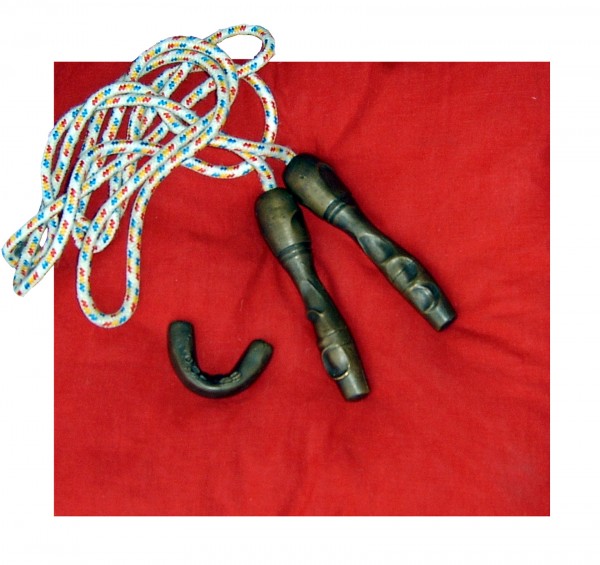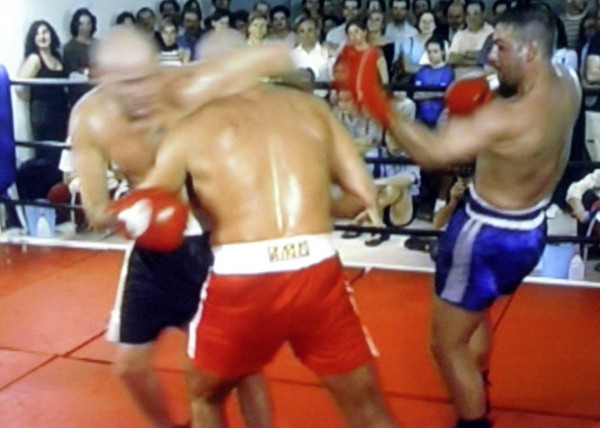Versus, 2002
Performed at Arte & Ricambi Gallery, Verona (I), June 1th, 2002
Camera and editing: Delfina Marcello
Versus, 2003
performed at Circuit Association d’Art Contemporaine, Lausanne (CH), June 28, 2003
Versus, 2002
C-print from video-still, cm 70 x 100
Gunnar, 2003, video still

Foreman, 2002
Pencil and marker on paper, cm 34 x 24

Versus, 2002
Small bronzes, life-size

Versus, 2002
Event’s poster
“I promoter e gli impresari sono gli allevatori, noi siamo il bestiame”. Questo stralcio di “The Journey Man”,* il recente libro autobiografico di Michael Murray, ex-promessa dei pesi massimi, è destinato a buttare benzina sul fuoco delle polemiche che da anni alimenta la generale avversione per il mondo della boxe.
I tempi di quando il pugilato veniva chiamato “arte nobile”, animando le penne di Jack London e Ernest Hemingway, sembrano oggi lontani anni luce, mentre gli entusiasmi di Norman Mailer, o le istanze sociali perpetuate da Mohamed Ali vengono guardate con nostalgia. E’ opinione diffusa che la boxe ormai non è altro che un veicolo d’uscita dal ghetto per picchiatori della strada. L’esasperato giro di scommesse e una serie di promoter senza scrupoli le hanno sottratto gli ultimi sprazzi di credibilità, e l’esame spettacolarità che il media televisivo ha fatto a tutti gli sport negli ultimi anni per valutarne l’efficacia l’ha vista clamorosamente sconfitta.
Don King, lo storico organizzatore del match Foreman/Ali a Kinshasa nel 1974, e considerato oggi il padre-padrone della boxe, non lo ammetterà mai, ma il suo ex-pupillo Mike Tyson, grazie alla sua tormentata vita pubblica, realizza molta più audience con una rissa da bar di 15 secondi con l’ultimo venuto di una sfida mondiale tra il campione in carica Lennox-Lewis contro Evander Holyfield. Sport barbaro, crudele, datato, ammesso che si possa ancora chiamare sport: le proposte per abolire la boxe sono fioccate da più parti, e l’uscita del libro di Michael Murray è accolta quasi come una conferma. Eppure la sentenza lapidaria che Murray dedica all’argomento abolizione nel suo atto d’accusa si rivela sorprendente: “Vogliono vietare la boxe, ma cosa sanno di noi? Cosa sanno della boxe? Non siamo forse consenzienti nel nostro dolore fisico? L’idea di abolire qualcosa di cui non si sa nulla è la cosa più ridicola che si possa dire”. Quella che sembra una contraddizione di termini sottolinea in realtà il punto saliente della questione: tante botte, pochi soldi, ma la boxe conserva ancora il suo fascino. Lo scontro uno contro uno, la scoperta dei propri limiti, la sofferenza estrema per conseguire il miglior risultato, probabilmente anche la totale assenza di orpelli tecnologici – che la lasciano ancora oggi quello che era cento anni fa – il quadrato del ring, le luci e due uomini che cercano di abbattersi a vicenda solo grazie alle loro mani. E’ il duello, la più antica forma di confronto per risolvere un contenzioso, e lo è nella sua versione più pura. E poi c’è l’allenamento, in senso sportivo tra i più completi in assoluto (molta corsa per le gambe, gran lavoro di braccia, e riflessi sempre pronti, oltre alla strategia: il pugile deve infatti studiare l’avversario per impararne i segreti, la tattica si sviluppa durante l’incontro, ed è necessario essere lucidi e presenti fino alla fine).
Al fascino della boxe neanche l’arte contemporanea ha saputo resistere. A partire dal famoso manifesto di Andy Warhol e Jean-Michel Basquiat negli anni Ottanta (recentemente riproposto da Tim Noble & Sue Webster), attraverso Steve McQueen, Mark Wallinger, fino a Carlos Amorales e Cameron Jamie, gli artisti hanno più volte preso in prestito le regole del ring, le misure del quadrilatero, e le dinamiche della lotta, analizzandone e smontandone sia gli aspetti formali che concettuali. L’operazione di Andrea Contin apparentemente non si discosta da quello che è considerato un normale incontro di boxe. C’è il ring, c’è il pubblico, c’è l’appoggio dell’associazione pugilistica locale, e tutto il folklore che solitamente circonda questi eventi. Come spesso però accade nel lavoro di Contin, un sottile scarto trasforma una situazione apparentemente ordinaria in qualcosa di completamente diverso. L’equilibrio dato dal normale trasferimento di una situazione sportiva all’interno delle pareti di una galleria è turbato dal fatto che i pugili sono tre. Impossibile immaginarsi quali saranno gli esiti di quest’incontro. La presenza del terzo contendente può rivelarsi sia un bonus in spettacolarità che un sacrilegio, se non tutti e due. “Versus” si propone quindi come una riflessione ironica sulla necessità di snaturare l’architettura delle cose nel nome di un voyerismo superficiale. E’ difficile sapere come reagirà il pubblico di “Versus” a questa ennesima incursione e relativa trasfigurazione del mondo reale in un contesto artistico. Ed è difficile sapere come ne uscirà il pugilato. Per quanto mi riguarda, posso dire che continuerò a stare alzato fino alle quattro di mattina per vedere la boxe da Atlantic City o da Las Vegas, pur con l’incognita che tale levataccia possa poi risolversi in sette secondi di incontro.
Michele Robecchi
*Nel gergo pugilistico vengono definiti “Journey Men” i comprimari, cioè quei pugili che vengono ingaggiati allo scopo di far fare bella figura al campione in attesa della sfida autentica.
“The promoters and managers are the farmers and we are the cattle”. This excerpt from “The Journey Man”,* Michael Murray’s recent autobiography, once a promising heavyweight, will inevitably fuel the polemics which for years now have been encouraging a general aversion to the world of boxing.
The days when boxing was called the “noble art”, as depicted in the writings of Jack London and Ernest Hemingway, now seem light years away, while the enthusiasm of Norman Mailer and the ripples Muhammad Ali generated on a social level can only be looked back on nostalgically. It is now widely believed that boxing is nothing but a way out of the ghetto for street fighters. Gambling and a number of unscrupulous promoters have deprived it of any credibility it still had and, sadly, after coming under the scrutiny of the TV media, just like every other sport, to assess its potential as a spectacle, boxing has emerged battered and bruised suffering a terrible defeat.
Don King, the famous promoter of the Ali/Forman match at Kinshasa in 1974 and now considered to be the real boss of boxing, would never admit it but, due to his troubled public life, his former pupil Mike Tyson would certainly attract a bigger TV audience for a 15 second brawl in a bar with some random bystander than a world title fight between the reigning champion Lennox Lewis and Evander Holyfield. A barbaric, cruel and outdated sport, assuming we can still call it a sport: proposals to abolish boxing have come from all over the place, and the publication of Michael Murray’s book merely seems to confirm this. And yet in this highly revealing book, Murray has something very pointed to say about the whole issue of abolishing the sport: “they want to ban boxing, but what do they know about us? What do they know about boxing? Are not we well aware of the physical pain we have to go through? The idea of abolishing something you know nothing about is the most ridiculous thing that anybody could say”. What appears to be a contradiction in terms, actually underlines the crux of the matter: lots of punches, not much money, but boxing is still as fascinating as ever. Man-to-man combat, discovering one’s own limits, suffering to the limit to achieve the best possible result and, most likely, the total absence of any technological frills – which means the sport is still the same today as it was a hundred years ago, – the ring itself, the lights and two men trying to overcome each other using only their hands. It is a dual, the oldest form of confrontation to settle an argument in its purist form. And then there is the training, the most complete sports preparation of all (lots of running for the legs, plenty of work to strengthen the arms and quick reflexes together with a careful strategy: a boxer must study his opponent to learn his secrets, tactics evolve during the bout, and you need to be clearheaded and very much in the moment right to the very end).
Boxing’s intriguing charm has even managed to capture the attention of contemporary art. Starting with the famous poster by Andy Warhol and Jean-Michel Basquiat from the 1980s (recently revived by Tim Noble & Sue Webster) and then through Steve McQueen, Mark Wallinger and most recently Carlos Amorales and Cameron Jamie, artists have frequently borrowed the rules and dimensions of the ring, the dynamics of fighting, analysing and dismantling both its stylistic and conceptual aspects. What Andrea Contin has done is apparently not that different from what is considered an ordinary boxing match. There is a ring, audience, the backing of the local boxing committee and all the folklore usually surrounding these events. But as often happens with Contin’s work, a subtle shift turns a seemingly ordinary situation into something completely different. The balance provided by the usual transferring of a sporting situation inside the walls of a gallery is disturbed by the fact that there are three boxers. It is impossible to envisage what the outcome of the fight will be. The presence of a third contender may turn out to be a bonus in terms of entertainment or a sacrilege, if not both. So “Versus” takes an ironic look at the need to pervert the structure of things in the name of superficial voyeurism. It is hard to imagine how the general public will react to “Versus”, to yet another foray into and relative transfiguration of the real world in an artistic setting. It is hard to envisage how boxing will come out of this. As far as I am concerned, I will carry on staying up until four o’clock in the morning to watch the boxing from Atlantic City or Las Vegas, even though you never know whether you are getting up at such an ungodly hour to watch a fight that might only last seven seconds.
Michele Robecchi
*In boxing jargon “Journey Men” are those boxers who are hired to make a real contender look good as they get ready for a real fight.




